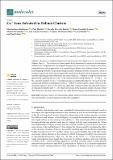Por favor, use este identificador para citar o enlazar a este item:
http://hdl.handle.net/10261/249817COMPARTIR / EXPORTAR:
 SHARE SHARE
 CORE
BASE CORE
BASE
|
|
| Visualizar otros formatos: MARC | Dublin Core | RDF | ORE | MODS | METS | DIDL | DATACITE | |

| Título: | Ca+ Ions Solvated in Helium Clusters |
Autor: | Bartolomei, Massimiliano CSIC ORCID ; Martini, Paul; Pérez de Tudela, Ricardo CSIC ORCID; González-Lezana, Tomás CSIC ORCID ; Hernández, Marta I. CSIC ORCID; Campos-Martínez, José CSIC ORCID; Hernández-Rojas, Javier; Bretón, José; Scheier, Paul | Palabras clave: | Molecular clusters Solvation Helium-alkaline earth ion interactions Helium nanodroplets Mass spectrometry Classical/quantum monte carlo calculations |
Fecha de publicación: | 15-jun-2021 | Editor: | Multidisciplinary Digital Publishing Institute | Citación: | Molecules 26(12): 3642 (2021) | Resumen: | We present a combined experimental and theoretical investigation on Ca+ ions in helium droplets, HeNCa+. The clusters have been formed in the laboratory by means of electron-impact ionization of Ca-doped helium nanodroplets. Energies and structures of such complexes have been computed using various approaches such as path integral Monte Carlo, diffusion Monte Carlo and basin-hopping methods. The potential energy functions employed in these calculations consist of analytical expressions following an improved Lennard-Jones formula whose parameters are finetuned by exploiting ab initio estimations. Ion yields of HeNCa+ -obtained via high-resolution mass spectrometry- generally decrease with N with a more pronounced drop between N = 17 and N = 25, the computed quantum HeNCa+ evaporation energies resembling this behavior. The analysis of the energies and structures reveals that covering Ca+ with 17 He atoms leads to a cluster with one of the smallest energies per atom. As new atoms are added, they continue to fill the first shell at the expense of reducing its stability, until N = 25, which corresponds to the maximum number of atoms in that shell. Behavior of the evaporation energies and radial densities suggests liquid-like cluster structures | Descripción: | 13 pags., 6 figs. -- This article belongs to the Special Issue Intermolecular Forces: From Atoms and Molecules to Nanostructures | Versión del editor: | https://doi.org/10.3390/molecules26123642 | URI: | http://hdl.handle.net/10261/249817 | DOI: | 10.3390/molecules26123642 | ISSN: | 1420-3049 |
| Aparece en las colecciones: | (CFMAC-IFF) Artículos |
Ficheros en este ítem:
| Fichero | Descripción | Tamaño | Formato | |
|---|---|---|---|---|
| molecules-26-03642.pdf | Artículo principal | 892,26 kB | Adobe PDF |  Visualizar/Abrir |
| molecules-26-03642-s001.zip | Supplementary information | 697,16 kB | Unknown | Visualizar/Abrir |
CORE Recommender
PubMed Central
Citations
2
checked on 09-may-2024
SCOPUSTM
Citations
5
checked on 06-may-2024
WEB OF SCIENCETM
Citations
5
checked on 29-feb-2024
Page view(s)
81
checked on 11-may-2024
Download(s)
68
checked on 11-may-2024

